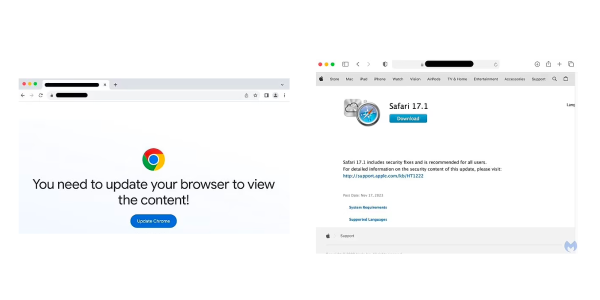Mac users, beware of this devious browser trick designed to steal your password!
By
VanessaC
- Replies 2
Scams on the internet are an unfortunate part of the digital advancements.
While antivirus software and mindful internet use can help, there are a number of new tactics being employed by devious cybercriminals to target unsuspecting victims.
Mac users (laptops designed and sold by Apple) are the latest target of a sophisticated scam that uses fake browser updates to steal passwords.
Cybersecurity experts urged vigilance as this new malware campaign, specifically targeting Apple products, gains momentum.
The scam involves tricking users into downloading a 'browser update' that is, in reality, a malicious virus designed to steal your data.
The cybercriminals behind this scheme have gone to great lengths to make their trap convincing, even creating malicious ads on Google that impersonate legitimate tech brands to lure unsuspecting victims.
Once you land on the fraudulent website, you're greeted with pop-ups prompting you to download a browser update to view the site.
These prompts are alarmingly convincing, and even the most tech-savvy users could be fooled if they're not aware of what to look for.
Dubbed 'ClearFake' by cybersecurity researchers, this malware is a new and more sophisticated version of the widely used Atomic Stealer attack.
Unlike its predecessor, which only targeted Windows machines, 'ClearFake' specifically targets Mac laptops.
Previously, hackers would hide the virus in fake versions of popular software like Microsoft Office, claiming they had been 'cracked' for free download. Now, they're buying ads on Google, likely through hijacked websites, to lure users.
Once the user is prompted to update their browser and instructed on how to open the file, the virus springs into action.
As soon as the target runs the program, the virus steals the user's data and sends it to a remote 'command and control server' to be collected and monetised by the criminals.
The ClearFake malware is so advanced that it can extract users' passwords, auto-fills, user information, wallets, browser cookies, and keychain data.
This level of data theft makes it one of the most dangerous social engineering schemes currently in operation, according to Jérôme Segura, a researcher at Malwarebytes.
'This may very well be the first time we see one of the main social engineering campaigns, previously reserved for Windows, branch out not only in terms of geolocation but also operating system.'
How to Stay Safe
To protect yourself from falling victim to this scam, it's crucial to use an anti-virus program or web protection service.
Be cautious when downloading files online and only use trusted sites.
If you're prompted to update your browser on a website, it's safer to ignore the prompt and manually update your browser through its official website or app.
As technology continues to evolve, so too will the tactics used by these criminals. Staying informed and taking proactive steps to protect your online security is more important than ever.
 Have you encountered any suspicious browser update prompts recently? Share your experiences in the comments below.
Have you encountered any suspicious browser update prompts recently? Share your experiences in the comments below.
While antivirus software and mindful internet use can help, there are a number of new tactics being employed by devious cybercriminals to target unsuspecting victims.
Mac users (laptops designed and sold by Apple) are the latest target of a sophisticated scam that uses fake browser updates to steal passwords.
Cybersecurity experts urged vigilance as this new malware campaign, specifically targeting Apple products, gains momentum.
The scam involves tricking users into downloading a 'browser update' that is, in reality, a malicious virus designed to steal your data.
The cybercriminals behind this scheme have gone to great lengths to make their trap convincing, even creating malicious ads on Google that impersonate legitimate tech brands to lure unsuspecting victims.
Once you land on the fraudulent website, you're greeted with pop-ups prompting you to download a browser update to view the site.
These prompts are alarmingly convincing, and even the most tech-savvy users could be fooled if they're not aware of what to look for.
Dubbed 'ClearFake' by cybersecurity researchers, this malware is a new and more sophisticated version of the widely used Atomic Stealer attack.
Unlike its predecessor, which only targeted Windows machines, 'ClearFake' specifically targets Mac laptops.
Previously, hackers would hide the virus in fake versions of popular software like Microsoft Office, claiming they had been 'cracked' for free download. Now, they're buying ads on Google, likely through hijacked websites, to lure users.
Once the user is prompted to update their browser and instructed on how to open the file, the virus springs into action.
As soon as the target runs the program, the virus steals the user's data and sends it to a remote 'command and control server' to be collected and monetised by the criminals.
The ClearFake malware is so advanced that it can extract users' passwords, auto-fills, user information, wallets, browser cookies, and keychain data.
This level of data theft makes it one of the most dangerous social engineering schemes currently in operation, according to Jérôme Segura, a researcher at Malwarebytes.
'This may very well be the first time we see one of the main social engineering campaigns, previously reserved for Windows, branch out not only in terms of geolocation but also operating system.'
How to Stay Safe
To protect yourself from falling victim to this scam, it's crucial to use an anti-virus program or web protection service.
Be cautious when downloading files online and only use trusted sites.
If you're prompted to update your browser on a website, it's safer to ignore the prompt and manually update your browser through its official website or app.
As technology continues to evolve, so too will the tactics used by these criminals. Staying informed and taking proactive steps to protect your online security is more important than ever.
Key Takeaways
- Cybersecurity experts have issued an urgent warning to Mac users about a fake browser update scam that steals passwords.
- The new malware, dubbed 'ClearFake', is disguised as a 'browser update' and is more sophisticated than previous attacks.
- Hackers are using fake pop-ups and even Google ads to trick users into downloading the malware.
- Users are advised to protect themselves by using a web protection tool, being cautious with downloading files, and checking the trustworthiness of sites.








